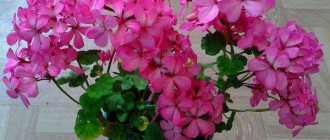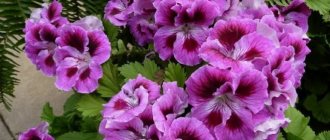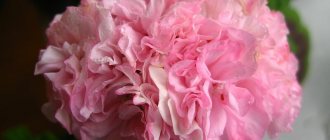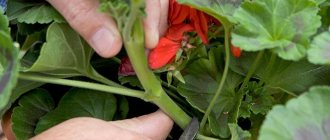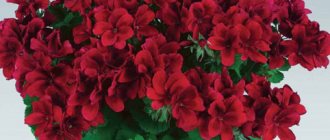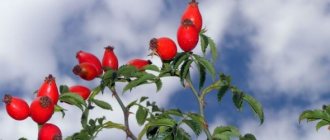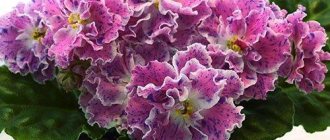Features of the view
The height of dwarf geranium ranges from 12.5–20 cm. This variety belongs to the beautifully flowering type. Thanks to the efforts of breeders, there are many varieties with a wide variety of petal colors. Flowering is usually long and lush.
Most often, dwarf pelargonium does not need shaping pruning, since it forms a neat bush on its own - this is very convenient for busy owners. However, please note: contrary to popular misconception, this property is not inherent in all dwarf varieties.
This plant looks stylish and noble both in an apartment and in an office interior. Well suited for landscaping balconies and verandas.
Varietal Pelargonium Rooted cuttings.
- Log in to reply to this topic
#1041
Post edited by Dashets: 03.11.2014, 08:12:06
- Top
#1042
I'm adding to the list. PAC Viva Madeleine-2500
New. The flowers are double, very large, creamy white with green and a pinkish glow from the inside. The leaves are green. The bush is very compact, I would even say dwarf. The bloom is incredible. It doesn't grow at all, it just blooms and blooms.
- Top
#1043
Adding to the main list!!
PAC Lilac Rose -1600 cuttings
compact ivy-leaved pelargonium from the German company Elsner pak Jungpflanzen. Another variety is rosebud. Ampel is distinguished by its most abundant flowering. The inflorescences are bouquets of fairly large pink-purple flowers of a pink shape. Stunningly beautiful variety! And, from my point of view, the most lilac-blue. No one else has this shade.
- Top
#1044
- Top
#1045
- Top
#1046
Post edited by Dashets: 05.11.2014, 12:34:08
- Top
#1047
Post edited by Dashets: 06.11.2014, 07:52:03
- Top
#1048
- Top
#1049
- Top
#1050
- Top
#1051
- Top
#1052
- Top
#1053
- Top
#1054
- Top
#1055
- Top
#1056
- Top
#1057
- Top
#1058
- Top
#1059
I add. MILLFIELD ROSE single cuttings 1700 tenge This beauty does not need advertising, everyone already knows and wants it. Pelargonium from the Ivy-hybrids group. Flowers with rose-shaped petals of soft pink color. The inflorescence is very large and dense. A very beautiful, completely unpretentious variety to care for. Blooms profusely and often. Disadvantage: difficult to root. The bush forms fluffy and wide. Doesn't like droughts. Otherwise, this is real luxury.
- Top
The best varieties
Let's look at the most popular varieties of dwarf pelargonium.
- Pink Ice. The bush is branched, strong and dense. Double flowers. The petals are quite long, soft pink in color, with a gradual lightening towards the edge. Cases have been recorded when one red flower could appear among the pink ones. Pink Ice is similar in many ways to the Natalie variety, but unlike it does not cause any problems with shaping. May be a little littered with petals.
- Jinky. The flowers are large, double, and form lush caps. The petals are pinkish-peach, sometimes with a cream tint. Closer to the core the color is especially rich. Flowering is long and abundant. The bush is airy and neat. The leaves are golden-green, often with an inner dark circle, giving them a special decorative appearance. Resistant to yellowing.
- Madame Salleron. This variety is valued primarily for its decorative gray-green leaves with a wide creamy-white border. The petioles are thin. The bush is very lush and does not emit the characteristic smell of geraniums. It blooms extremely rarely, with simple bright pink flowers. Bred in 1877
- Silk Moira. The inflorescences are dense, densely double, forming caps. The petals can be apricot or pale salmon. The top ones are usually a little darker. The leaves are golden green. The bush is compact, with short internodes, and grows quickly. Zoning on the leaves is weakly expressed, but in bright sun it can become noticeable.
- Clatterbridge. Pelargonium is a zonal type with a fluffy and dense bush. The flowers are densely double, fiery scarlet, and do not litter with petals. Collected in caps 9–10 cm in diameter. In bright sunshine, the petals acquire a crimson hue over time. Flowering is abundant and long. The leaves are small, the internodes are short.
- Pac Harmony. The flowers are semi-double, quite large (from 5 cm), juicy dark pink, lighter near the core. Owners of this flower unanimously note the early and extremely abundant and long “uncontrollable” flowering. Even a young bush quickly grows a large number of large inflorescences. The variety readily bushes and grows wider than tall. The foliage is scalloped and attractive.
- Deacon Suntan. The flowers are semi-double, bright orange, with a lighter underside and a white center. Collected in dense inflorescences, almost the size of a palm. The caps look especially large compared to the compact bush - according to reviews, sometimes they can even outweigh, causing the pot to fall. Flowering is long. The plant begins to throw out inflorescences at a young age. The shoots grow slowly, the bush sometimes remains at the miniature level (less than 12.5 cm), and not dwarf.
- Dylan Cherone. The flowers are speckled, double, with a pink or lilac-white background and burgundy markings. With plenty of light and fresh air, the shades become more saturated and the specks become brighter. Flowering is abundant, flower stalks are formed from almost every leaf axil.
- Marie Louise. The variety is distinguished by the unusual shape of the flowers: they do not open completely, which is why they resemble tulips. The decorative effect of the flowers is enhanced by the wavy edge. The petals are light peach with a transition to cream, sometimes salmon. There is a light border. The bush grows quite slowly.
- Diana Palmer. Geranium of zonal type. The flowers are semi-double, pastel orange, shaped like carnations. Quite large (4–4.5 cm). Flowering begins early, sometimes barely rooted cuttings are already forming buds. The variety does not bush on its own and requires pinching. The bush is relatively large. Leaves stop growing after flowering begins.
Varieties
Among the varieties presented below, each gardener will be able to choose a flower to his liking or create an ensemble of several beauties in his flowerbed.
- Pelargonium Foxy forms large caps. The foliage is painted in dark green tones, flowering occurs without any problems. The culture can hardly be called whimsical.
- Ivy-leaved pelargonium Vicky produces bright pink flowers. Judging by the descriptions, the closer the row of petals is to the center of the flower, the shorter it is.
- Blue Wonder is simply a gorgeous flower crop. The flower belongs to the zonal varieties. Semi-double flowers are painted in a non-standard lilac-bluish tone. In the very middle of the flower there is a white spot. The dark green leaves look very elegant.
- Lauretta, which produces semi-double flowers, has cyclamen-colored caps. The stocky bush branches heavily. Pink pelargonium with a white center looks very attractive.
- Lilac Rose is another ivy-leaved type. The plant produces dense double flowers of a delicate lilac color; Moreover, the bushes are relatively small.
- First Yellow is a rather rare variety, because yellow pelargoniums like it are not very familiar to gardeners. The variety was introduced back in the late 2000s, so experience with it has already been accumulated.
- Mexica Nealit creates pink-lilac flowers, from the middle of which a white ornament appears to emerge.
- The Victor variety fully lives up to its name. The flower of this pelargonium is very large and is characterized by a velvety red tone. The diameter is 0.05 m.
- As for pelargonium Angeleyes Orange , this variety has good resistance to frost. The flowers of the plant are small, which is compensated by their abundance. The culture is suitable for both home and outdoor conditions.
- The variety Emilia is a typical zonal pelargonium. The caps of this plant are quite large. Semi-double flowers are pink in color.
- Pelargonium Ameta is also popular. It's hard not to admire this purple flower with lavender eyes. The plant itself is medium in size, but the buds and flowers are invariably large.
Growing rules
In order for geranium to delight with lush, abundant flowering, it is important to create comfortable conditions for it.
Like other varieties, dwarf pelargonium needs plenty of light: without it, the foliage and flowers turn pale, the sprouts become disproportionately elongated, and the leaves become smaller. The optimal place for growing will be a south window. It is desirable that the light be diffused, but direct sunlight for several hours a day is also allowed. However, if the leaves begin to turn yellow and dry, the flower needs to be moved to more gentle conditions. In winter, additional lighting is desirable: the optimal daylight hours for this plant is 16 hours.
It is important to maintain a balance of watering. On the one hand, in warm weather it should be plentiful and regular; on the other hand, the roots of pelargonium react very painfully to stagnant water, so it is important that the soil is loose, well-permeable to moisture and air.
When watering, water should not fall on the leaves. Air humidity does not matter for geraniums. You cannot spray it. In winter, watering is reduced by half.
Breeding rules
Zonal geranium is propagated mainly in two ways - seeds and cuttings. The first method is suitable for those who want to grow a flower from scratch. The package with the seeds should indicate at what time it is recommended to grow the seedlings - most often this is done at the end of winter.
The seeds are first soaked in warm water, and then the substrate is transplanted and kept in a warm, well-lit place, regularly moistening and fertilizing. By spring, the sprouts have grown so large that they can be transplanted into a pot, and already in the summer such plants are able to produce their first buds.
Propagation by cuttings helps to obtain the desired plant, which will be a complete copy of the mother flower. To do this, a shoot is cut from the mother plant, kept in dry, humid conditions for a couple of days, and then, like a regular plant, it is transplanted into a pot with soil suitable for pelargonium. You can first place the shoot in a glass of water and keep it there until roots form, but this will not change the quality of growth. It is recommended to water the young shoot regularly and keep it on a well-lit windowsill.
We wish you success in growing zonal pelargonium!
'Minca'
'Minca'
Post by IrinaS » July 23, 2022, 6:19 pm
The first flowering was like this
then this
'Minca'
Post by Lyudmila Pivovarova » July 23, 2022, 11:07 pm
'Minca'
Post by IrinaS » July 24, 2022, 8:57 pm
'Minca'
Post by IrinaS » 11 Aug 2022, 19:23
'Minca'
Post by Olga55 » 14 Aug 2022, 07:22
'Minca'
Post by IrinaS » 14 Aug 2022, 15:07
'Minca'
Post by IrinaS » 17 Sep 2022, 18:27
'Minca'
Post by Olga55 » 17 Sep 2022, 20:55
'Minca'
Post by marinka » 26 Feb 2022, 13:05
'Minca'
Post by Pepino » 01 Mar 2022, 12:05
The flowers are small, very small for my taste, although they have a beautiful shape and color. Mine were no more than 3 cm. In the photo with the Deacon Gala flower.
'Minca'
Post by Svetik-ok » Mar 29, 2022, 5:09 pm
I will also share my impressions about this variety. I've had it for a year, but I already have a lot of emotions from communicating with this variety. From the excitement of anticipation, disappointment and fascination. I purchased a cutting from Irina from Kazan. Nice, fluffy. I transplanted it into a larger pot, and it started.
This girl grew strangely - at each point of growth it forked, or even produced three shoots, new leaves were deformed. I even wrote to Irina with a bunch of questions about how to deal with this variety: “A bunch of small leaves have grown, about 8 growing points. And it turns out that the whole bush is covered with this little thing and is not growing. My thoughts on this matter: it is necessary to thin out, remove some growth points so that the strength goes to the remaining ones; or perhaps this is the nature of growth when there are a lot of leaves and it grows slowly (and I’m expecting fast growth); Well, maybe this variety has some features that I wanted to ask you about. Yes, the shape of its leaf blade is also different from ordinary varieties, as it seemed to me.” Irina answered me: “Svetlana. Good evening! The variety is new to many, including me. The specifics of growth are like this. But I recently decided to straighten it, leaving the largest branches - They, of course, also fork. But this is its specificity. The flowers are very beautiful. This is what attracts the variety. But you have to try to please.” I pleased this peculiar girl in every possible way, and she thanked me with a gorgeous flower. What is possible for this little girl. As Pepino wrote above, the flowers are really small, 2-3 cm, but the bush is also small. Over the spring and summer it grew 20 centimeters in height. Moreover, I didn’t pinch her, I gave her complete freedom, and fed her like everyone else.
Unfortunately, only this photograph of the flowering remains. Yes, now, in the spring, after pruning, my Minca is also overgrown - small deformed leaves, several growth points from one.
Fragrant pelargonium for flavoring
The fragrant leaves of this plant can be included in potpourri for aromatic pillows. From fragrant pelargonium you can make infusions to add flavor to preserves or jams. Candied leaves make a beautiful material for decorating cakes.
- Pelargonium Prince of Orange (Prince of Orange) - orange;
- Pelargonium guercifolium - frankincense;
- Pelargonium graveolens, Pelargonium tomentosum (swamp) - minty;
- Pelargonium fragrans Group - nutmeg;
- Pelargonium capitatum (capitate) - pink;
- Pelargonium radens - pink-lemon;
- Pelargonium odoratissimum - apple.
The aromatic leaves of pelargonium are good in soups, stews and cheese dishes. Leaves for these purposes should be plucked in reasonable quantities before the inflorescences open. Fragrant geranium essential oil is also extracted from pelargonium leaves.
Pelargonium catalogue: Mini
Miniature double pelargonium with disproportionately large flowers. Plant height is 15 cm. I liked the delicate pink-coral shade with transitions, very long flowering, leisurely growth.
Zonal miniature terry pelargonium. Rich dark wine shade of flowers. Very cute pelargonium!
Miniature zonal double pelargonium. Abundant flowering of very large double coral flowers. An adult plant reaches 15cm.
Miniature semi-double zonal pelargonium. Bright flowers on golden foliage. Variety perfection! Would look great solo. Participated in the exhibition in July 2022.
Terry miniature zonal pelargonium. Flowering is very abundant. Fluffy bush! The flowers are bright red.
Zonal miniature pelargonium. The porcelain-white-pink flowers are very delicate. The bush is neat and modest.
Miniature zonal terry pelargonium. Scarlet flowers, very bright! The leaf is dark green and dense. The bush is compact and fluffy. Pom pom hats! Participated in the exhibition in July 2022.
Pelargonium emperor nicholas
Pelargonium rosebud Prins Nikolai is an early, long-flowering variety. The flowers are arranged in several rows and during flowering resemble a bouquet of unblown roses.
Description Pelargonium rosebud Prince Nikolai (Pelargonium rosebud Prins Nikolai). Compact variety, characterized by early and long flowering. The leaves are a uniform green color. For abundant flowering, it requires cold maintenance for 4-6 weeks (December-January).
Among the large species diversity of unpretentious pelargoniums, Pelargonium rosebud deserves special attention. A true aristocrat, it is distinguished by beautiful large foliage of various shapes depending on the variety, lush inflorescences consisting of large (up to 5 cm) flowers. In shape they resemble rose flowers, single or double. The petals can be painted in a wide variety of colors: from white to dark red, through all the variety of pinks, reds and purples; they can be plain or with spots, streaks, corrugated, fringed or torn. Flowering is very abundant and colorful, lasting from May-June to August-September. The shoots of rosebud pelargonium become lignified at the base. Like other varieties, pelargonium leaves are hairy and have a characteristic aroma, but many varieties have odorless leaves.
Location Pelargonium rosebud Prince Nikolai (Pelargonium rosebud Prins Nikolai). The optimal location for rosebud pelargonium is an eastern window with diffused sunlight, but without a heating radiator under the window sill. This species is not suitable for planting in the garden in the summer, as it is afraid of rain and wind, but feels good on closed verandas, terraces and loggias. When the first frost occurs, the plant must be moved to a warm place.
Temperature regime for Pelargonium rosebud Prince Nikolai. Pelargonium rosebud does not tolerate extreme heat: at temperatures significantly above +25 ° C, it stops growing and does not bloom. In winter, the optimal temperature is within +15. +20 °C.
Planting Pelargonium rosebud Prince Nikolai (Pelargonium rosebud Prins Nikolai). The best container for planting rosebud pelargonium will be a ceramic pot with perforations to drain excess moisture. Be sure to provide drainage, and use a mixture of turf soil with a high organic content as a substrate. Within two weeks after planting, provide the plants with shade and timely watering.
Care of Pelargonium rosebud Prince Nikolai (Pelargonium rosebud Prins Nikolai). The main conditions for the successful cultivation of rosebud pelargonium are compliance with the correct temperature conditions, additional lighting and moderate watering. Regular pinching of the tops of the shoots ensures better tillering of the bush, but it must be stopped long before flowering to allow buds to form. Young plants bloom more abundantly than adults, so annual propagation of pelargonium is recommended. During the period of active growth, feed plants with low doses of fertilizers with a high content of potassium and microelements. During the period from March to August, provide the plants with regular watering, but do not allow stagnation of moisture. Remove fading inflorescences promptly.
Grow lush beauty at home - dwarf pelargonium!
Dwarf pelargonium is gaining the attention of gardeners every day. Such wide demand is due to the plant’s unpretentiousness in care.
Due to its compact size, the flower does not take up much space on the windowsill. In addition, dwarf pelargonium blooms profusely.
This article describes in detail how to properly care for dwarf pelargonium, what diseases and pests can attack the flower. You will also learn how to properly propagate this beautiful plant.
Blooming house
Good day to everyone who has visited the pages of my site.
in pelargoniums 2016 I want to show both the oldies of my collection and the new varieties.
Edwards Elegans. Large, white-pink flower caps with jagged edges of the petals. Delicate but expressive flowering of this variety. The bush does not cause problems, it forms well. This variety is part of my main collection. Not all varieties of the Edwards series performed well in my conditions content, but this particular variety has a permanent residence permit.
Ludwigsburger Flair.. my good old variety, which still appeals to me now. One of the first to appear on my windowsill, lives to this day. Was, is and will always be! I love its gentle tints in the caps, the greenness of the leaves and the tractability of the content.
new Greenacres , an upstart with long peduncles, the bush needs to be formed immediately, the variety is recognizable both by the bush and the flowers - this is a big plus. The flowers are porcelain-white, the petals are dense, wavy, the first caps are very large, lacy. There is also a minus. The variety still tries after pinching drive the top into two, three branches at best.
Calypso's favorite , this spring almost all the cuttings taken from the plant in February took root; last year there was only one rooted cutting from this variety over the summer. As soon as the variety started flowering, and it blooms profusely and for quite a long time, cuttings from it practically do not take root .
Lara Harmony is a wonderful variety that can bloom well both on the window and on the street. The photo shows a heavily pruned mother plant in a pot growing on the street. It quickly grew...blooms.
new varieties this year
BROOKSIDE KATERINA . Beauty, beauty and beauty again! Bright, bold in color, with a white backlight radiating across the petals from the center of the flower... you can notice this immediately, expressive and spectacular pelargonium... I really liked it. Large flower, neat cap. Grows slowly, forming a fluffy bush.
Gerda , very helpful in the bush, strong, stocky, well formed. The caps are large, full-bodied, voluminous.
another new one. Odensjo Madame Bovary
As soon as she showed the first flower... that's it! it was love, right away... this variety is very difficult to photograph. Delightful, deep and velvety red and dark foliage. The variety is very beautiful and contrasting! The inflorescence is not large, but this is for now, the plant is still young.
Anita , blooms from cuttings, sets flower stalks well, very delicate in color, fluffy inflorescences...balls of roses!
Prince Gustav...a prince he is a prince!
I probably took the shape of a leaf from the mother tulip, also slightly curled and harsh to the touch, medium in size, shiny. Not lazy, it lays flower stalks actively, even very actively. It took me a long time for an autumn cutting to take root, it survived the winter normally, but in the spring, in the best place on the windowsill, it dropped a fair amount of foliage, then after transplanting it into a spacious pot, it began to grow a bush. He liked it most on the balcony, having received an abundance of light and air... the bush was transformed! Variety definitely interesting and deserves attention. The buds look like ice cream balls, they take shape slowly, the inflorescence stays fresh for a long time.
Common varieties and photos
You can purchase dwarf pelargonium of the following types, look at the photo.
Jinky
The advantage of the variety is large double flowers of light creamy color . At the very core the petals are deep pink. The plant itself is tender and airy, the leaves are light green in color.
Pink Ice
It is a mini bush that is stocky and branchy despite its compact size. The petals are elongated, terry, and pale pink in color.
Read more about Pink pelargonium and its varieties in this material.
Clatterbridge
This decorative crop belongs to the group of zonal dwarf pelargoniums. The peculiarity of the variety is its intense flowering . The buds are terry type and bright red in color.
Silk Moira
The variety is distinguished by salmon-colored petals. It is not picky in care, and the process of forming a bush also does not require much effort.
You can learn more about Pelargonium Silk and its species - Moira, Laguna, Aurora and others, as well as see photos of flowers here.
Madame Maleron
This variety does not bloom at all, but its main advantage is its dark green leaves with a light edge.
How to grow good pelargonium (geranium) seedlings: when and how to plant, care, dive
We buy most indoor flowers and decorative foliage plants already in pots in garden centers and stores, or we propagate them by cuttings at home.
However, many of them can be grown through seedlings, for example, the familiar pelargonium (another name for geranium). A wonderful perennial houseplant can not only decorate window sills throughout the year, it can also be taken out into the garden in the summer as a container plant or even planted in open ground for one summer season. Dwarf pelargoniums are a special species: graceful and miniature, they can be located on one windowsill in a picturesque group. To grow the plant, a very small pot is enough - the height of this pelargonium usually does not exceed 15 cm.
But, despite its small size, dwarf pelargonium blooms very beautifully, quite fully. The inflorescences are arranged in groups, forming characteristic caps. The color of the petals varies depending on the variety, but the foliage almost always has a dark, emerald green hue.
Home care
Temperature
In summer, dwarf pelargonium prefers to grow in moderate temperatures - 17-23 degrees Celsius. Overheating must not be allowed. In winter, the optimal temperature remains 12-13 degrees, but not higher, since during this period the flower rests.
Watering
Dwarf pelargonium responds positively to soil moisture, so you need to water it regularly and abundantly. In summer, moisturizing is done every other day, and in winter – once a week. It is important to ensure that the soil dries thoroughly before watering .
Top dressing
The plant must be fed regularly, especially during the growing season - from March to November. In winter, the plant does not require additional nutrition, as it rests.
Phosphorus or potassium should be used as fertilizing , and it is important not to overdo it with nitrogen. If this element is in excess, the green mass will begin to grow actively, but flowers will not form. Complex fertilizers must be applied once every 2 weeks.
Molding
In order for the bush to be lush, it is necessary to regularly pinch out young shoots.
This manipulation will enable the plant to form a large number of lateral branches, as a result of which the decorative appearance of pelargonium will improve. Sometimes the shoots become very elongated during the winter, so in the spring they have to be removed by 1/3 of their growth. If the cuttings are healthy and strong, they can be rooted. Then there will be even more beautiful and graceful pelargoniums in the house.
Brief botanical description of Pelargoniums Margaretha and Prins Nikolai
Pelargonium Margaretha looks attractive due to the combination of dense inflorescences, brightly colored petals and a compact crown.
Margarita is an early, long-flowering variety and can delight with lush caps for 6 months if it is in favorable conditions.
Margaretha caps are formed by dense flowers, which, due to the close fit of the petals, resemble unopened buds of garden roses.
The color of the inflorescences is rich red, but in insufficient lighting the variety loses its intense color and turns pale. To preserve the brightness of the petals, it is recommended to grow Margarita only on the sunny side.
Rosebud pelargonium Margaretha is a variety with a compact crown and uniform green foliage. In some cases, a characteristic zone appears in the form of a dark semiring.
The plant needs shaping to stimulate better branching and lush flowering. To do this, the bush is pruned in the fall, and regularly pinched in the warm months to achieve the desired result.
Rosebud variety Prins Nikolai
It is the complete opposite of Margarita in color - this pelargonium has pale white inflorescences. The plant looks aristocratic and elegant when contrasting caps rise above the crown.
Pelargonium Prince Nicholas opens double buds, which reveal a creamy center as they bloom. Due to the transition from white to cream, the inflorescences look impressive and unusual.
The leaves of Prins Nikolai are medium in size, with light pubescence typical of zonal geraniums. The contrasting half-ring on the leaf plates appears in conditions of sufficient lighting.
To obtain a harmonious crown, Prins Nikolai requires regular pruning and pinching, which is carried out throughout the entire active growing season.
Timely removal of dried inflorescences prolongs budding, so it is necessary to constantly inspect the bush. Weak, dry shoots directed into the bush are subject to complete pruning.
It is advisable to grow both varieties in small pots with a maximum volume of 1.5 liters - in this case, the plants will not waste energy on developing the earthen clod, but will direct them to lush flowering.
Margaretha and Prins Nikolai are propagated vegetatively - to obtain young bushes, strong cuttings are taken from the mother plant and rooted in loose, nutritious soil, not forgetting about pinching when the shoots take root.
Diseases and pests
The most common pests that attack dwarf pelargonium remain:
To combat parasites, it is necessary to use the following drugs: Aktara, Confidor.
Dangerous diseases include:
- Black leg . This is root rot, which occurs as a result of excessive soil moisture and insufficiently high air temperatures. There is no cure for blackleg, so the affected plant must be disposed of immediately. The soil that remains in the pot must also be disposed of.
- Swelling and rotting of leaves . A pathological process occurs as a result of excessive watering. And at low temperatures the foliage begins to turn red. To prevent this, it is necessary to move the pot away from the window glass on frosty days.
- Stretching and exposing stems . Occurs as a result of lack of light. To solve this problem, you need to place the flower pot in a well-lit room. If there is no flowering, it is because the air temperature is too high during wintering.
Planting and further care
All representatives of the Salmon group are unpretentious and the same care can be applied to them as for other varieties of pelargonium. This involves regular moderate watering and fertilizing from spring to late autumn at intervals of 2-3 weeks.
For planting, use standard soil, which can be purchased at the store, or you can mix garden soil with sand and peat in a ratio of 2/1/1.
Attention! A drainage layer is required. Plants do not tolerate waterlogging and stagnation of moisture.
Pruning can be done before or after flowering. Peduncles are removed and shoots that are too long are shortened.
Advice from gardeners on the care and winter storage of pelargoniums
When buying young specimens of pelargonium, it is better to choose strong ones, with one or two blossoming inflorescences, so as not to go wrong with its preferred color.
- In order for the aesthetic appearance of a pelargonium bush or bush to be attractive, and the flowering to be long and abundant, fading flower caps should be regularly removed, the pedicels of which are then bent and pulled down and they come off safely. If seeds are needed, then all the more energy of the plant remains for them.
- It was necessary to leave the pelargonium for a long vacation (two weeks), but they were in full bloom. Absolutely ruthlessly cut off all the inflorescences, and if for more than two weeks, then all the inflorescences-buds. Upon your return, you will be greeted by your pet looking quite well.
Garden specimens of plants in pots can be stored in winter in a cool but frost-free room with minimal watering, cutting them off by about half. Remove browning and dying leaves periodically. In the spring it will perk up and intensive care needs to be resumed.
Beauty from Africa - captivating pelargonium
Pelargoniums are members of the Geraniaceae . Unlike garden geraniums, pelargoniums are heat-loving plants that came to us from a mild climate and are naturally found in the subtropical zone. South Africa is considered the birthplace of all pelargoniums.
It is the origin that determines the heat-loving nature of plants: despite the fact that pelargoniums are used in landscape design, they are not crops that can overwinter in open soil in regions with harsh winters. Pelargoniums require protection for the winter by moving them indoors. Pelargoniums are competitors of bright annuals and plants with a completely different scope of use from garden geraniums.
Pelargoniums are herbaceous evergreen subshrubs and perennials with fibrous compact rhizomes, forming bushes from 30 to 60 cm in height. It is no coincidence that strong, woody shoots of pelargoniums are not visible under the mass of leaves: sloppy and bulky, they can spoil the entire appearance of the plant in a neglected state.
Among pelargoniums there are also species with more delicate stems. The leaves on long petioles of all pelargoniums seem exquisite. In some species they are round, in others they are kidney-shaped, in others they are feathery. A solid edge is more common than a jagged edge, and the wavy almost always creates a more elegant effect. Lacy or whole, pelargonium leaves always look festive, thanks to the bright shades of color, with different zones and stripes that repeat the shape of the leaf itself, and a velvety, special edge.
Pelargonium flowers rarely bloom one at a time. They are collected in 2-3, and sometimes in several dozen flowers in apical umbrella-shaped inflorescences on thin pedicels. The special texture of the petals emphasizes the asymmetrical structure and shape of the individual petals - from oval or round to almost elongated lanceolate.
Beautiful veins appear on the bright, delicate petals of pelargonium, and in most varieties, contrasting dark spots also appear on the two upper or two lower petals. The color palette of pelargoniums includes unique shades of pink and red, including unique fruit, watercolor and two-color options.
Pelargoniums bloom from spring to autumn. Some varieties last only a few weeks, others last more than six months and delight with their bright inflorescences.
The aroma of pelargonium is definitely familiar to everyone. Modern honeycombs of pelargonium are characterized by a rich palette of aroma shades, which transform the simple sweet-spicy-floral aroma of “geranium” into an almost perfume masterpiece. Lemon, orange, cedar, nutmeg aromatic notes of individual varieties of pelargonium enchant. And each type of plant smells differently.
Pelargonium flowers rarely bloom one at a time; they bloom magnificently and for a long time. © ast2009
